Between Colorado Springs in El Paso County and the Florissant Fossil Beds National Monument in neighboring Teller County to the west, one doesn’t simply travel some 30 miles in distance but also some 36 million years in time, back to the late Eocene (56 to 33.9 million years ago), when the Florissant Valley was covered in redwood forests that thrived in a warm and humid climate. The name of the geologic epoch is derived from Greek, where eós means dawn, and kainós means new, and references the “new” age of mammals after the dinosaurs’ demise following the impact of a destructive asteroid circa 66 million years ago.
Serial eruptions of a cluster of nearby volcanoes sent clouds of superheated gas and ash as well as mud flows into the Florissant Valley, burning and burying everything in their wake. The mud flows engulfed the bases of trees and formed Lake Florissant in which fine-grained volcanic ash entombed countless life forms, thereby creating one of the richest deposits of plant and insect fossils on earth (the volume of ejected material was one thousand times greater than during Mount St. Helens eruption in 1980).
When the first fossils were unearthed by humans is not documented, but it’s likely that groups of Utes and other Native tribes stumbled across them when they camped seasonally in the valley which is located in their ancestral homelands. In 1873, the community of Florissant was founded a few miles south of the Florissant Valley, along a route traveled by Indigenous Peoples for centuries which followed a natural east-west corridor across the mountains of the Front Range. This corridor became known as Ute Pass and was eventually transformed into US Highway 24, on which Florissant is reached today.
Among the settlers in the Florissant Valley several stand out and if you have followed my blog for a while, you might remember my post about The Hornbek Homestead. Adeline Hornbek wasn’t the only woman who homesteaded on the future National Monument. Charlotte Hill was one of her contemporaries and neighbors. Born in Indiana in 1849, she moved to Colorado City with her family at age 11 and married only 2 years later. Charlotte and Adam Hill had 7 children, 2 of whom died before the age of two. They settled in the Florissant Valley in 1874 where, besides homesteading and rearing their children, Charlotte became intrigued by the fossils found on their land and started collecting and cataloguing them.
Scientists began to visit the fossil site in the late 1870s and were impressed by Charlotte’s collection and self-taught expertise. One of them named three fossil species in her honor, the fossil rose (Rosa hilliae) among them. Charlotte found the fossil of a butterfly, Prodryas persephone, which counts among the best-preserved butterfly fossils in the world. It represents a brush-footed butterfly (Nymphalidae) whose modern-day relatives still fly and flutter through the Florissant Valley today.
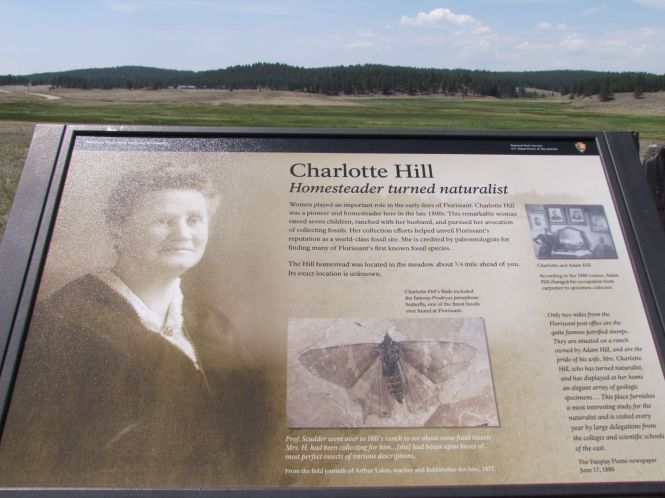
Charlotte Hill, homesteader turned naturalist (1849-1930). The sign reads “The Hill homestead was located in the meadow about 1/4 mile ahead of you. The exact location is unknown. The portrait shows Charlotte Hill later in life, not when she homesteaded and discovered fossils. It was provided to the Herbert Meyer by Charlotte’s 90-plus-year-old grandson in 2009 when family members were invited to celebrate her 160th birthday. It was the first time anyone at the Monument saw her face.
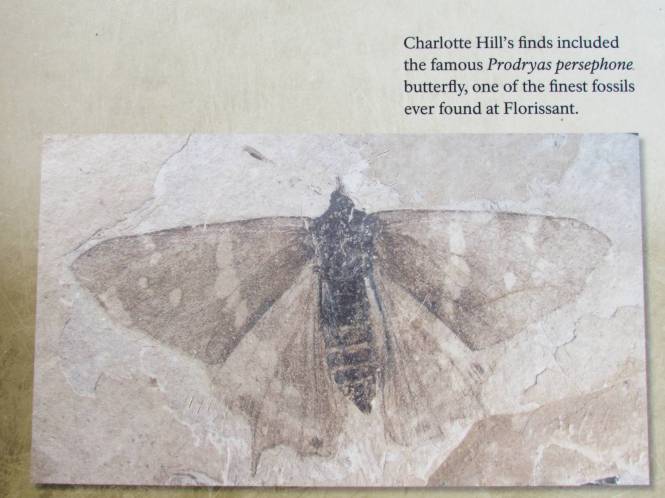
Fossil of Prodryas persephone, found by Charlotte Hill
For reasons unknown, the Hills left the Florissant Valley in 1883 and Charlotte’s contributions were largely forgotten until recently, when she was honored in a 2011 publication. Saved in Time: The Fight to Establish Florissant Fossil Beds National Monument, Colorado was co-authored by Estella B. Leopold, daughter of esteemed forester and conservationist, Aldo Leopold, and by Herbert W. Meyer, National Park Service paleontologist. Estella Leopold, who was a biology professor, paleoecologist, ardent conservationist, and member of the National Academy of Sciences (alongside two of her four siblings), passed away on February 25, 2024 at the age of 97. Here is a link to her obituary which outlines her remarkable life and accomplishments.
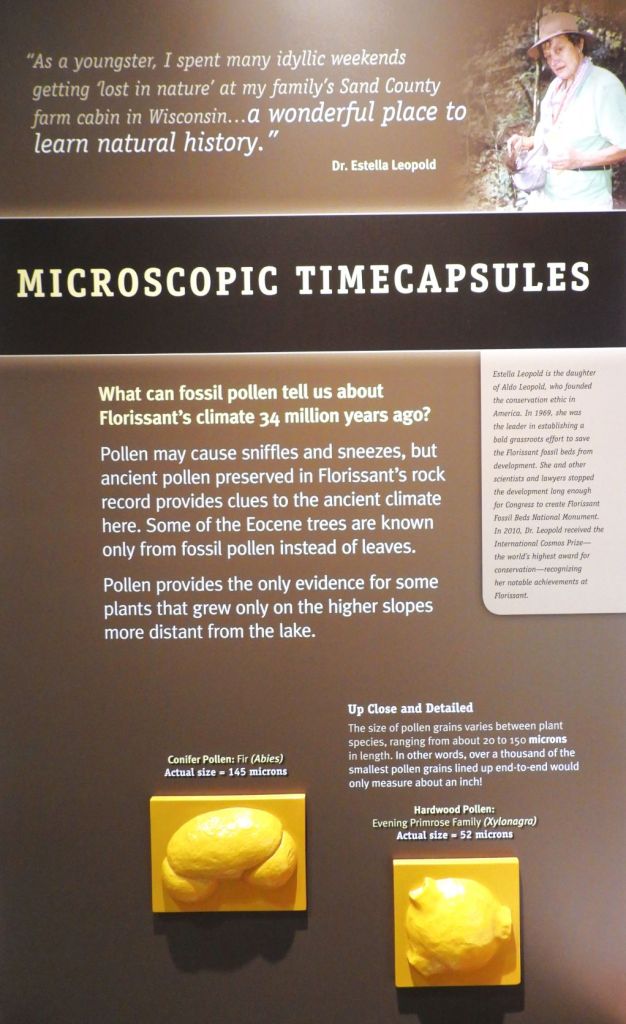
Estella Leopold became an expert on fossil pollen
In the late 19th and early 20th centuries, the fossils of Florissant Valley drew tourists and collectors and the cars of the Midland Railroad disgorged hordes of visitors intent on collecting fossils, as well as wildflowers. The sheer numbers of both that were removed over the course of decades boggle the mind. No less mind-boggling is the fact that the land under which the fossils are deposited was slated for real estate development in the 1960s. Today we owe a debt of gratitude to all those whose banded together in an attempt to stop such a desecration, Leopold and Myers among them.
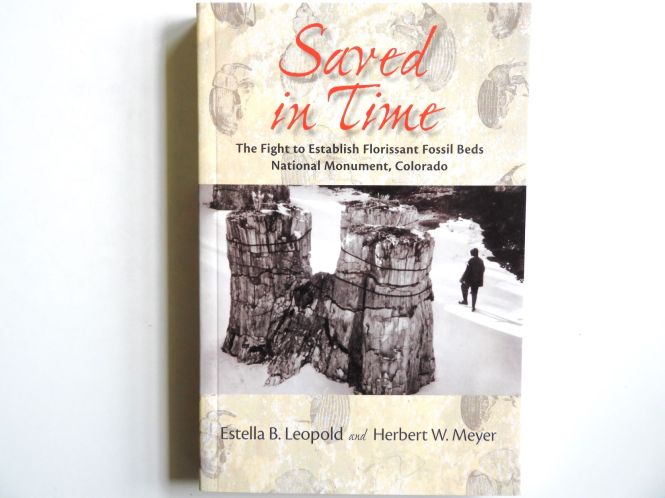
The following is taken from the back cover of Saved in Time:
In the summer of 1969, a federal district court in Denver, Colorado, heard arguments in one of the nation’s first explicitly environmental cases, in which the Defenders of Florissant, Inc. opposed real estate interests intent on developing lands containing and extraordinary set of ancient fossils. This book, the first account of the fight to preserve the Florissant fossil beds, tells a story of environmental activism that remains little known almost fifty years after the coalition’s victory.
The case rode a ground swell of public support from an unlikely coalition of people—conservationists, scientists, outdoor enthusiasts, and local ranchers—whose voices were echoed and reechoed by the press.
The attorney for Defenders of Florissant, Inc., Victor Yannacone Jr. famously remarked in court:
The Florissant fossils are to geology, paleontology, paleobotany, palynology [the science of pollen and spores] and evolution what the Rosetta Stone was to Egyptology. To sacrifice this 34-million-year-old record, a record you might say written by the mighty hand of God, for 30-year mortgages and the basements of A-frame ghettoes of the seventies is like wrapping fish with the Dead Sea Scrolls.
Luckily for us, National Monument status was granted to the fossil beds on August 20, 1969, protecting and preserving this one-of-a-kind treasure trove with 1,800 identified fossil species to date. We try to visit there a few times each year, experiencing the different seasons. The Visitor Center houses an interesting museum and bookstore and a film about the history of the fossil beds plays on a loop every 30 minutes.
To enlarge a photo, click on it. To read its caption, hover cursor over it.
Just outside the Visitor Center one can marvel at the fossilized stumps of trees that once covered the area. The mudflows that followed the volcanic eruptions (aka lahars) buried the bases of giant redwoods which were subsequently turned to stone in a process called permineralization.
The Florissant Fossil Beds National Monument is also known for its natural beauty which can be explored on roughly 14 miles of trails. In next week’s post I will share some impressions gathered along those trails.
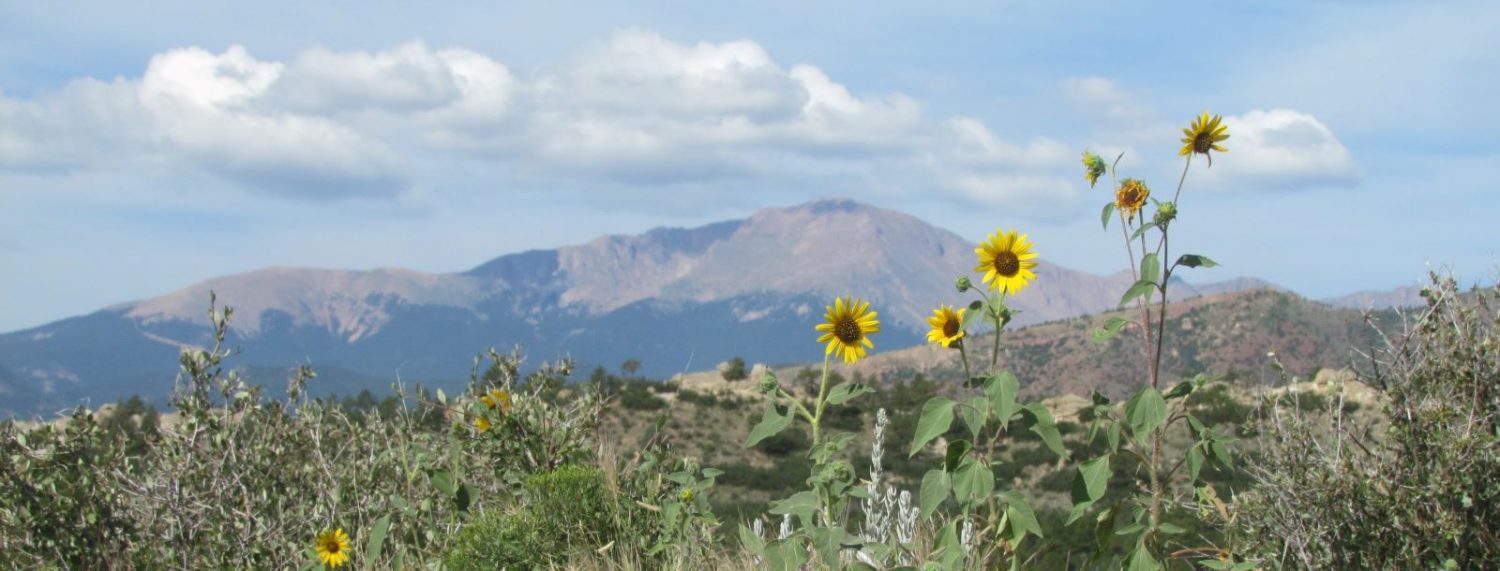








What a fascinating spot Tanja. That butterfly fossil is incredible. Maggie
LikeLiked by 2 people
thank you, Maggie. Yes and yes. 😊
LikeLike
It’s good to have you confirm in pictures and words that Florissant has continued flourishing (which is what French fleurissant means) after gaining National Monument status. The quotation about wrapping fish with the Dead Sea Scrolls is reminiscent of stories—perhaps true, probably not—of Bach scores having been similarly used as wrapping paper. You’re fortunate to have Florissant close enough to visit several times a year.
Greek ēōs, meaning ‘dawn,’ is related to German Ost and English east: dawn is when the sun rises in the east.
LikeLiked by 1 person
Florissant flourishes, indeed, as does the visitor who gets to enjoy it. I don’t often make it there by dawn, even though it’s my favorite time of day, when Eos rises in the East and brings us a new day with all its potential.
LikeLike
The transformations that have taken place on our planet over millions/billions of years are beyond incredible. And these kinds of things happen continually throughout the universe. Totally mind-boggling.
LikeLiked by 1 person
I wholeheartedly agree with you, Neill, even though (or because) I have never been able to wrap my mind around such incredible time spans. Our lives, in comparison, are so short.
LikeLiked by 1 person
Sehr interessant liebe Tanja.
Ein spannender Ort ist das.
Danke fürs Vorstellen.
Liebe Grüße Brigitte
LikeLiked by 1 person
Danke für Dein Interesse und Kommentar, liebe Brigitte. Es ist wirklich faszinierend sich vorzustellen, was an diesem Ort zu verschiedenen Zeiten passiert ist, und wie kurz unser Leben im Vergleich dazu ist.
Herzliche Grüße zurück,
Tanja
LikeLiked by 1 person
Incredible history of prehistory.
To think that but for the determination of a few individuals, we could all have been treated to a lovely – subdivision.
LikeLiked by 1 person
I love that, Wally: Incredible history of prehistory.
I have learned about so many places or buildings that only exist because someone somewhere was interested and dedicated enough to speak out and to make an effort to protect them, and I’m very grateful for them and their actions.
LikeLike
That’s an amazing number of fossil species! The butterfly is beautiful and in wonderful condition – what a find!
LikeLiked by 1 person
Can you imagine trying to plant a garden to feed your family and to come across some of these fossils in the process?!
Maybe we need to dig a little deeper when we are gardening. 😊
LikeLiked by 1 person
I’m always hoping for Roman remains in mine… 🙂
LikeLiked by 1 person
I hope you will find some!
LikeLiked by 1 person
You never know…there have been finds within a couple of miles or so…though medieval is probably more likely.
LikeLiked by 1 person
Very exciting!
LikeLiked by 1 person
What a special place! Thank goodness there were activists willing to spend their time and energy on preserving it. The fossil of the butterfly is particularly beautiful.
LikeLiked by 1 person
Thank you, Julie, I feel exactly the same way and am very thankful to all those individuals.
LikeLiked by 1 person
I love this place so much! Thanks for your post, it brought back fun memories for me of my visit a few years back.
LikeLiked by 1 person
Thank you, Diana, I’m glad this reminded you of your time there I remember reading your post about your visit. It’s a little nearer for us than for you, and it’s nice to be able to go back there regularly.
LikeLiked by 1 person
That butterfly fossil is amazing. Really enjoyed this read.
LikeLiked by 1 person
Thank you, Brian, that makes me happy. It’s a fascinating place with a fascinating history and we are lucky that it’s so close.
LikeLike
Was für ein Glück, daß dieser Ort erhalten werden konnte. Die Versteinerungen sind wundersam wie schön. Besonders der Schmetterling ist zauberhaft. Die Versteinerung hat etwas von einer Momentaufnahme und sie ist so gut, daß man sie für ein Foto halten könnte. Auch die Baumstümpfe sind beeindruckend. Schöner Beitrag Tanja, vielen Dank dafür! LG
LikeLiked by 1 person
Danke für Deinen positiven Kommentar, liebe Almuth. Wir alle dürfen dankbar sein, daß sich damals eine Gemeinschaft Besorgter gefunden hat, die sich für den Erhalt dieses einzigartigen Ortes eingesetzt haben. Egal, wie oft wir ihn besuchen, wir sind immer wieder von Neuem beeindruckt.
Liebe Grüße zurück,
Tanja
LikeLiked by 1 person
Und es zeigt, wir können etwas bewirken 🙂 LG
LikeLiked by 1 person
This is wonderful, Tanja. What a fascinating place.
LikeLiked by 1 person
Fascinating, indeed. I’m glad you think so, too!
LikeLike
What a treasure this monument is, with such perfectly preserved fossils. So grateful for the foresight of those who worked to protect it!
LikeLike
Thank you for your comment, Eliza, and sorry for the late response. Somehow, WP sent your comment to my spam folder. 😦
All of us should be grateful that this place was preserved for posterity, it’s very special.
LikeLiked by 1 person
Wow! What a fun place to add to our “Places to visit in Colorado” list. Maybe even next week. Thanks Tanja!
LikeLiked by 1 person
Definitely a “must-see” place, Brad! I have a feeling that your to-do list for Colorado only keeps growing, no matter how many places you visit. 😊
I hope you will have a lovely visit with your family!
LikeLiked by 1 person
Thank you. We will be there next weekend.
LikeLiked by 1 person
Good for you. I hope it won’t be as hot as this week and weekend.
LikeLiked by 1 person
As with Brad, will definitely try to get this added to our agenda the next time we are out in that area….which might be sooner than later as I saw Linda had the Colorado maps out the other day … wondering what she has planned ha.
LikeLiked by 1 person
Thank you, Brian. I, too, wonder what Linda has planned. Maybe you should mark the spot with an X on the map! 😊
LikeLike
What a fascinating place! Very interesting history and thank goodness, it’s was saved from any sort of development.
LikeLiked by 1 person
Thank you, Tina. I second all your statements! 😊
LikeLike
What a fascinating post. I’d never heard of the Florissant Fossil Beds, nor of Charlotte Hill. It’s good to know that Charlotte’s insights have finally received the recognition they deserve.
The butterfly fossil sounds particularly wonderful.
LikeLiked by 1 person
Yes, fascinating all around. And extra special because it’s so close to us and can be re-experienced repeatedly.
LikeLiked by 1 person
The butterfly fossil is amazing in its detail. I, for one, have never seen anything like it.
I can well imagine the delight in the finder when first spotting it.
LikeLiked by 1 person
It’s a special place, Vicki. I have seen fossils embedded in rocks before, but have never discovered any on my own. The realization of holding history in one’s hands must be very special.
LikeLike
Oh, I do so love fossils! How wonderful to have those “geological gem” places near you!
One part of your article struck me as very timely, as well:
“The case rode a ground swell of public support from an unlikely coalition of people—conservationists, scientists, outdoor enthusiasts, and local ranchers—whose voices were echoed and reechoed by the press.”
Wouldn’t it be wonderful if people today formed an “unlikely coalition” regarding conservation, and the press echoed their voices? We are so splintered today that it seems nearly impossible to get any diverse groups to agree on anything!
Thanks for this post. Your pics are amazing!
Cheers to summer!
Julie
LikeLiked by 1 person
Thank you, Julie. I had similar thoughts when I read the quote about the coalition that managed to preserve this wonderful place.
I fear that many people are too busy with their lives and gadgets to really stand up, speak out, and, when necessary, march for what they believe in, and what our planet needs.
I hope your summer will be pleasant and not too hot.
Best,
Tanja
LikeLike
Auch mich hat das Fossil of Prodryas persephone sehr beeindruckt. Das würde ich mir so wie es ist, glatt an die Wand hängen. Ich liebe es, wenn sich Menschen für etwas so liebevoll engagieren. VG Simone
LikeLiked by 1 person
Das Schmetterlingsfossil hat sehr viele Fans, verständlicherweise! An der Wand würde es sicherlich auch sehr gut zur Geltung kommen. 😊
Und daß sich Menschen für einen guten Zweck engagieren, macht immer wieder Hoffnung.
LikeLiked by 1 person
Beeindruckender Beitrag und bei Charlotte Hill habe gestutzt. Sie hat mit 13 geheiratet, 7 Kinder bekommen und vieles mehr geleistet. Eine bemerkenswerte Frau mit unglaublichen Fähigkeiten, wie ihre Sammlung mit dem wunderschönen Schmetterlingfossil
Liebe Grüße Andrea
LikeLiked by 1 person
Dankeschön, liebe Andrea. Ich war auch erstaunt zu lernen, wie früh Charlotte Hill geheiratet hat und wie oft sie gebar. Neben den Kindern, dem Haushalt, dem Garten und wahrscheinlich noch mehr Verpflichtungen, hat sie Zeit gehabt, sich den Fossilien zu widmen. Aber es ist auch leicht sich vorzustellen, wie sich ihr dadurch eine ganz neue Welt eröffnet hat.
Liebe Grüße zurück,
Tanja
LikeLiked by 1 person
I was so surprised to see Florissant in your title. I’ve been in two Florissants — one in Missoui, near St. Louis, and one in Louisiana, south of New Orleans. It’s interesting that both of those places are near rivers — the Missouri and Mississippi respectively — although ‘your’ Florissant developed for different reasons. I’d never heard of the Florissant fossil beds, and found the account fascinating.
I suppose it’s the contrast between the delicacy of a butterfly and the solidity of rock able to withstand aeons of wear that makes that image so striking to most of your commenters: myself included.
It was especially interesting to refresh my memory of geological epochs. The Cretaceous preceded the Eocene; during the Cretaceous, the Western Interior Seaway spread roughly from the Rockies to Appalchia, and covered most of Texas. I’ve been lucky enough to have access to land rich in fossils from that time, so have a basket filled with Kerr County gastropods and such. I have examples of everything shown in the top row here. The bivalve is popularly known as a deer heart fossil; it’s one of my favorites.
One of my best stops in Kansas was the Cretaceous era Monument Rocks. When I looked at the map, I discovered Florisssant is almost exactly due west, and only four hours farther. If I make it back to Kansas, a little jaunt into Colorado would be perfect.
LikeLiked by 1 person
“All good things come in threes!” I have never heard this said in English, but it is how my online dictionary translates the German expression, “Aller guten Dinge sind drei.”
At least I hope you will find it so after you visit your third Florissant the next time you are in Kansas and can plan in a slight detour. I don’t think you would be disappointed. The Colorado Florissant is a flourishing place (as Steve pointed out).
The fact that such fine details were imprinted and preserved in hard rock is one of the many marvels of a fossil.
LikeLiked by 1 person
One more tidbit: The reason the town Florissant and Florissant Fossil Beds carry their name is because they were named by a man from Florissant, Missouri, after he settled in Colorado: James Castello.
LikeLiked by 1 person
That’s really interesting, and especially fun that my initial thought of one of the Florissants I’ve known led to this revelation of its connection to the fossil beds.
LikeLiked by 1 person
[…] Fossil Beds National Monument. If you didn’t travel there with me last week, please do so here for background and […]
LikeLike
Thanks for that highly informative post, Tanja!
LikeLiked by 1 person
Thanks for your interest and comment, Pit. If you are ever in the vicinity, it’s a marvelous place to visit.
LikeLike
I’d love to!
LikeLiked by 1 person
Faszinierend geschrieben, so ein Schmetterlingsfossil kann ich mir gar nicht vorstellen.
LG
Maren
LikeLiked by 1 person
Danke, liebe Maren. Außer dem Schmetterling gibt es noch viele gut erhaltene Insekten und Pflanzen, und es ist faszinierend, die feinsten Details in den Fossilien erkennen zu können. Dort wurden wirklich wunderbare Entdeckungen gemacht.
LikeLiked by 1 person
Das ist ja wirklich faszinierend. Das Thema ist mir nicht so bekannt, außer Dinos natürlich.
LIebe Grüße
Maren
LikeLike
At first, when I saw this post, I thought it was about Florescent Fossil Beds; Why did the paleontologist love the fluorescent fossil beds? Because they really shined a light on the past! But, my reading comprehension and vision improves with my first morning cup of coffee. Cheers!
LikeLiked by 1 person
Now I need to go back there to try to find the fluorescent fossil beds. I need all the illumination I can get!
LikeLiked by 1 person
I think I may BE a fluorescent fossil. Dem bones Dem bones, those titanium knees.
LikeLiked by 1 person
Sadly, I can relate . . .
LikeLiked by 1 person
Really interesting how the redwoods were turned to stone through per-mineralization. This aspect of the State of Colorado is fascinating and now I’m even more interested in all this history.
LikeLiked by 1 person
Thank you for your interest and comment, Maria. This is a fascinating place and I learn something new each time we visit. I always try to wrap my mind around the span of time and the major geologic events that have happened there. Big changes, indeed. Yet at the same time, tiny details were preserved in fossils. It really boggles the mind.
LikeLike
The fossil pollen is very interesting, and read this article (you probably already have it) that has many diagrams which show all kinds of trees, even worldwide:
https://www.nps.gov/flfo/learn/nature/microscopic-timecapsules.htm
LikeLike
Well, mainly conifers and marshes. I read the article and with its diagrams could visualize the scope.
LikeLiked by 1 person
Isn’t it amazing that a pollen grain can survive for millions of years and still provide us with answers to burning questions?!
LikeLike
Yes, it’s amazing, thanks for this valuable information!
LikeLiked by 1 person
I enjoyed learning about it too.
LikeLiked by 1 person